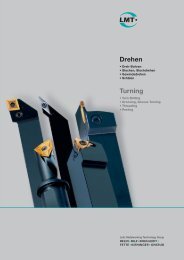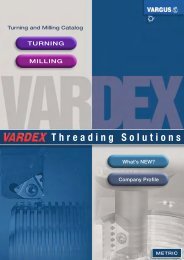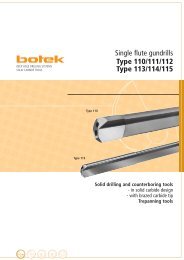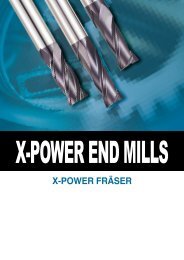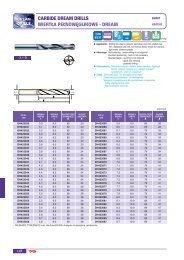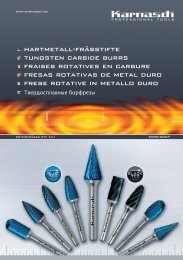Gear Cutting Tools
Hobs - Torion
Hobs - Torion
- No tags were found...
Create successful ePaper yourself
Turn your PDF publications into a flip-book with our unique Google optimized e-Paper software.
<strong>Cutting</strong> conditions<br />
<strong>Cutting</strong> speed<br />
The cutting speed depends on the<br />
module size and on the hardness<br />
of the gear. As an approximate value,<br />
a cutting speed of 36 m/min<br />
can be quoted for module 30 and<br />
of 110 m/min for module 2.<br />
For the lower modules, higher values<br />
between 140 and 160 m/min<br />
are also possible. These high<br />
cutting speeds do however reduce<br />
the service life of the skiving hob<br />
and the workpiece structure is increasingly<br />
affected.<br />
For workpiece hardness values<br />
from HRC 62 upwards, the cutting<br />
speed should be limited initially to<br />
70 m/min and then optimized in<br />
consideration of the cutting result<br />
and the service life of the tool.<br />
Feed<br />
The structure of surfaces machined<br />
with hobs is affected by the<br />
depth of the feed markings. The<br />
depth of the feed mark increases<br />
quadratically with the value of the<br />
feed. It is therefore logical to distinguish<br />
between feeds for finishing<br />
and for roughing.<br />
Approximate value for the feed:<br />
For the finishing cut<br />
1.5 to 2 mm/workpiece rotation<br />
for the roughing cut<br />
up to 4 mm/workpiece rotation<br />
Climp hobbing method<br />
Climb hobbing for skive hobbing is<br />
preferred since this yields the best<br />
service life of the skiving hobs.<br />
Removal per flank<br />
To maintain a reasonable service<br />
life of the hobs, not more than<br />
0.15 ÷ 0.20 mm/flank should be<br />
removed in one cut.<br />
For high quality requirements,<br />
hobbing must always be done in<br />
several cuts. For the last cut, a removal<br />
of 0.1 mm/flank should be<br />
aimed at, to affect the structure of<br />
the gear material as little as possible.<br />
Cooling<br />
Intensive cooling of the tool, workpiece,<br />
holding fixture and machine<br />
with the cutting oils usual for hobbing,<br />
the temperature-dependent<br />
error values are reduced and the<br />
service life of the skiving hobs is<br />
extended.<br />
Wear and tool life<br />
values<br />
Wear mark width<br />
The wear mark width on the skiving<br />
hobs should not exceed 0.15<br />
mm.<br />
<strong>Cutting</strong> forces increase with greater<br />
wear mark width and with very<br />
thin chips deflection of the hob<br />
cutting edges will occur.<br />
This may have the following consequences:<br />
quality losses, chipping of carbide<br />
cutting edges and excessive<br />
structural changes through tempering<br />
and re-hardening processes<br />
on the gears.<br />
Uniform wear through<br />
shifting<br />
Wear only occurs on the tooth<br />
flanks of the skiving hobs. The<br />
wear marks are relatively short<br />
and follow the contour of the engagement<br />
lines.<br />
By shifting the hob in the axial direction<br />
after hobbing a gear or set<br />
of gears, the wear is distributed<br />
evenly over the flank cutting edges<br />
and over the entire cutting edge<br />
length of the hob. This process is<br />
further facilitated if the hobbing<br />
machine is equipped with a synchronous<br />
shifting arrangement.<br />
This arrangement ensures that the<br />
machine table makes an additional<br />
turn when the tangential slide is<br />
moved. The relative position of the<br />
hob motion then remains as set<br />
during centering.<br />
Tool life between regrinds<br />
The life between regrinds of a hob<br />
equals the sum of the lengths of all<br />
hobbed workpiece teeth between<br />
two regrinds of the hob.<br />
The calculation of the life between<br />
regrinds, the tool requirement, the<br />
proportional tool costs etc. is<br />
based on the life between regrinds<br />
per cutter tooth. This depends on<br />
the module value and on the hardness<br />
of the material being cut. Experience<br />
has shown the tool life<br />
between regrinds to lie between 2<br />
and 4 m per cutter tooth for skive<br />
hobbing.<br />
<strong>Gear</strong> cutting quality<br />
The gear quality when skive hobbing<br />
depends on the interaction of<br />
a large number of components and<br />
parameters, such as:<br />
■ skiving hob (cutting material,<br />
correctly sharpened, sufficent<br />
accuracy)<br />
■ rigid hobbing machine<br />
■ accurate and stable clamping<br />
of hob and workspiece<br />
■ hob aligned with an absolute<br />
minimum of runout<br />
■ accurate centering<br />
■ correct selection of cutting<br />
speed, feed and metal removal<br />
per flank<br />
■ adherence to the maximum<br />
wear mark width<br />
■ material, preparation and heat<br />
treatment of the workpieces<br />
42



